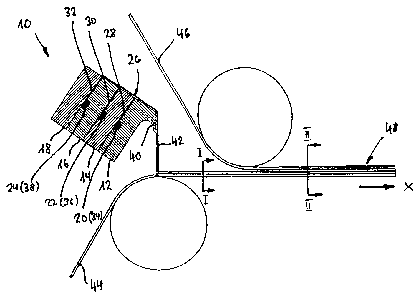Some of the information on this Web page has been provided by external sources. The Government of Canada is not responsible for the accuracy, reliability or currency of the information supplied by external sources. Users wishing to rely upon this information should consult directly with the source of the information. Content provided by external sources is not subject to official languages, privacy and accessibility requirements.
Any discrepancies in the text and image of the Claims and Abstract are due to differing posting times. Text of the Claims and Abstract are posted:
| (12) Patent Application: | (11) CA 2571098 |
|---|---|
| (54) English Title: | PROCESS FOR MANUFACTURING A LAMINATE |
| (54) French Title: | PROCEDE DE FABRICATION D'UN STRATIFIE |
| Status: | Deemed Abandoned and Beyond the Period of Reinstatement - Pending Response to Notice of Disregarded Communication |
| (51) International Patent Classification (IPC): |
|
|---|---|
| (72) Inventors : |
|
| (73) Owners : |
|
| (71) Applicants : |
|
| (74) Agent: | NORTON ROSE FULBRIGHT CANADA LLP/S.E.N.C.R.L., S.R.L. |
| (74) Associate agent: | |
| (45) Issued: | |
| (22) Filed Date: | 2006-12-13 |
| (41) Open to Public Inspection: | 2007-06-21 |
| Examination requested: | 2008-01-16 |
| Availability of licence: | N/A |
| Dedicated to the Public: | N/A |
| (25) Language of filing: | English |
| Patent Cooperation Treaty (PCT): | No |
|---|
| (30) Application Priority Data: | ||||||
|---|---|---|---|---|---|---|
|
A process for manufacturing a laminate (48) out of two film-shaped substrates
(44, 46) as outer layers joined together by means of adhesive layers (34, 38)
and at least one functional intermediate layer (36) is such that a first
substrate
(44) is coated, by liquid film coating using curtain coating or slide coating,
with a
multi-layer liquid film comprising at least two outer adhesive layers (34, 38)
and
at least one functional intermediate layer (36) and optionally at least one
additional intermediate layer (35, 37) and is subsequently bonded to the
second
substrate (46). The process makes it possible to manufacture laminates with
barrier properties in a simple and cost-favourable manner.
Note: Claims are shown in the official language in which they were submitted.
Note: Descriptions are shown in the official language in which they were submitted.

2024-08-01:As part of the Next Generation Patents (NGP) transition, the Canadian Patents Database (CPD) now contains a more detailed Event History, which replicates the Event Log of our new back-office solution.
Please note that "Inactive:" events refers to events no longer in use in our new back-office solution.
For a clearer understanding of the status of the application/patent presented on this page, the site Disclaimer , as well as the definitions for Patent , Event History , Maintenance Fee and Payment History should be consulted.
| Description | Date |
|---|---|
| Application Not Reinstated by Deadline | 2011-11-03 |
| Inactive: Dead - No reply to s.30(2) Rules requisition | 2011-11-03 |
| Deemed Abandoned - Failure to Respond to Maintenance Fee Notice | 2010-12-13 |
| Inactive: Abandoned - No reply to s.30(2) Rules requisition | 2010-11-03 |
| Inactive: S.30(2) Rules - Examiner requisition | 2010-05-03 |
| Letter Sent | 2008-04-03 |
| Request for Examination Received | 2008-01-16 |
| Request for Examination Requirements Determined Compliant | 2008-01-16 |
| All Requirements for Examination Determined Compliant | 2008-01-16 |
| Amendment Received - Voluntary Amendment | 2008-01-16 |
| Application Published (Open to Public Inspection) | 2007-06-21 |
| Inactive: Cover page published | 2007-06-20 |
| Letter Sent | 2007-05-01 |
| Inactive: Single transfer | 2007-03-13 |
| Inactive: IPC assigned | 2007-02-27 |
| Inactive: IPC assigned | 2007-02-27 |
| Inactive: IPC assigned | 2007-02-27 |
| Inactive: IPC assigned | 2007-02-27 |
| Inactive: First IPC assigned | 2007-02-27 |
| Inactive: IPC assigned | 2007-02-27 |
| Inactive: Filing certificate - No RFE (English) | 2007-01-30 |
| Application Received - Regular National | 2007-01-19 |
| Abandonment Date | Reason | Reinstatement Date |
|---|---|---|
| 2010-12-13 |
The last payment was received on 2009-11-25
Note : If the full payment has not been received on or before the date indicated, a further fee may be required which may be one of the following
Patent fees are adjusted on the 1st of January every year. The amounts above are the current amounts if received by December 31 of the current year.
Please refer to the CIPO
Patent Fees
web page to see all current fee amounts.
| Fee Type | Anniversary Year | Due Date | Paid Date |
|---|---|---|---|
| Application fee - standard | 2006-12-13 | ||
| Registration of a document | 2007-03-13 | ||
| Request for examination - standard | 2008-01-16 | ||
| MF (application, 2nd anniv.) - standard | 02 | 2008-12-15 | 2008-11-28 |
| MF (application, 3rd anniv.) - standard | 03 | 2009-12-14 | 2009-11-25 |
Note: Records showing the ownership history in alphabetical order.
| Current Owners on Record |
|---|
| ALCAN TECHNOLOGY & MANAGEMENT LTD. |
| Past Owners on Record |
|---|
| HANS-RUDOLF NAEGELI |